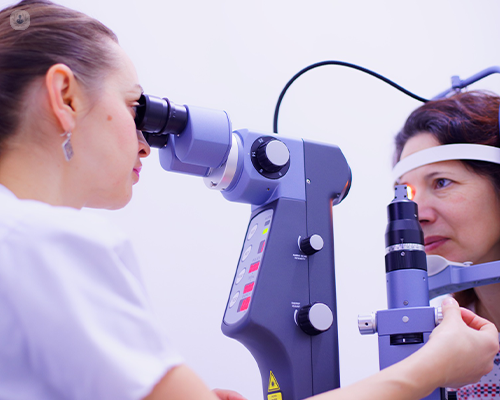Understanding selective laser trabeculoplasty (SLT) for glaucoma
Written by:Glaucoma is a common eye condition that can lead to vision loss if not effectively managed. Selective laser trabeculoplasty (SLT) is a laser treatment option for glaucoma. Leading consultant ophthalmic surgeon Mr Hussameddin Muntasser provides simple and informative answers to key questions for adults considering SLT.

What is Selective Laser Trabeculoplasty (SLT)?
Selective laser trabeculoplasty (SLT) is a laser-based procedure used to treat open-angle glaucoma. It targets the trabecular meshwork, enhancing the drainage of aqueous fluid from the eye to reduce intraocular pressure.
How does SLT differ from other glaucoma treatments?
Unlike traditional laser treatments, SLT selectively targets specific cells in the trabecular meshwork, leaving surrounding tissues unaffected. This selective approach minimises the risk of scarring and complications associated with other laser therapies.
Who is a suitable candidate for SLT?
SLT is typically recommended for individuals with open-angle glaucoma or ocular hypertension and it is now the first line treatment as per the latest NICE guidelines, it can be also used for those who have not responded well to or cannot tolerate glaucoma medications.
How does SLT work to lower intraocular pressure?
During SLT, the laser stimulates the pigmented cells in the trabecular meshwork, promoting increased drainage of aqueous fluid. This process helps to lower intraocular pressure, a key factor in managing glaucoma.
Is SLT a painful procedure?
SLT is generally well-tolerated and considered minimally invasive. Most patients experience little to no discomfort during the procedure, which is performed on an outpatient basis.
What should I expect during the SLT procedure?
The SLT procedure typically involves the following steps:
Preparation: The eye is numbed with local anaesthetic eye drops.
Laser application: The laser is precisely applied to the trabecular meshwork, a process that usually takes a few minutes.
Observation: After the procedure, the eye is observed, and the patient can usually resume normal activities.
How long does it take to see results after SLT?
The full effect of SLT may take a few weeks to manifest. In some cases, additional treatments or adjustments to existing medications may be necessary to achieve optimal intraocular pressure control.
Are there potential side effects of SLT?
While SLT is considered safe, some individuals may experience:
Temporary increase in intraocular pressure: This usually resolves on its own or with additional treatment.
Mild discomfort or redness: Transient symptoms that typically subside shortly after the procedure.
Can SLT reduce or eliminate the need for glaucoma medications?
For some individuals, SLT can effectively reduce the need for glaucoma medications. However, it’s essential to note that results vary among patients, and ongoing monitoring is crucial to ensure sustained intraocular pressure control.
Is SLT a one-time procedure or does it require repeat treatments?
SLT is often effective with a single treatment. However, the duration of its effectiveness varies from person to person. Some individuals may require repeat treatments over time to maintain optimal intraocular pressure control.
Selective laser trabeculoplasty (SLT) is a valuable option in the management of glaucoma, offering a targeted approach to reduce intraocular pressure and preserve vision. If you are considering SLT or exploring treatment options for glaucoma, consult with an ophthalmic surgeon who can assess your specific condition and provide personalised recommendations. Understanding the benefits and considerations of SLT is a crucial step towards proactive eye care and maintaining long-term visual health.
If you require an SLT procedure done by an expert, arrange a consultation with Mr Muntasser via his Top Doctors profile.


